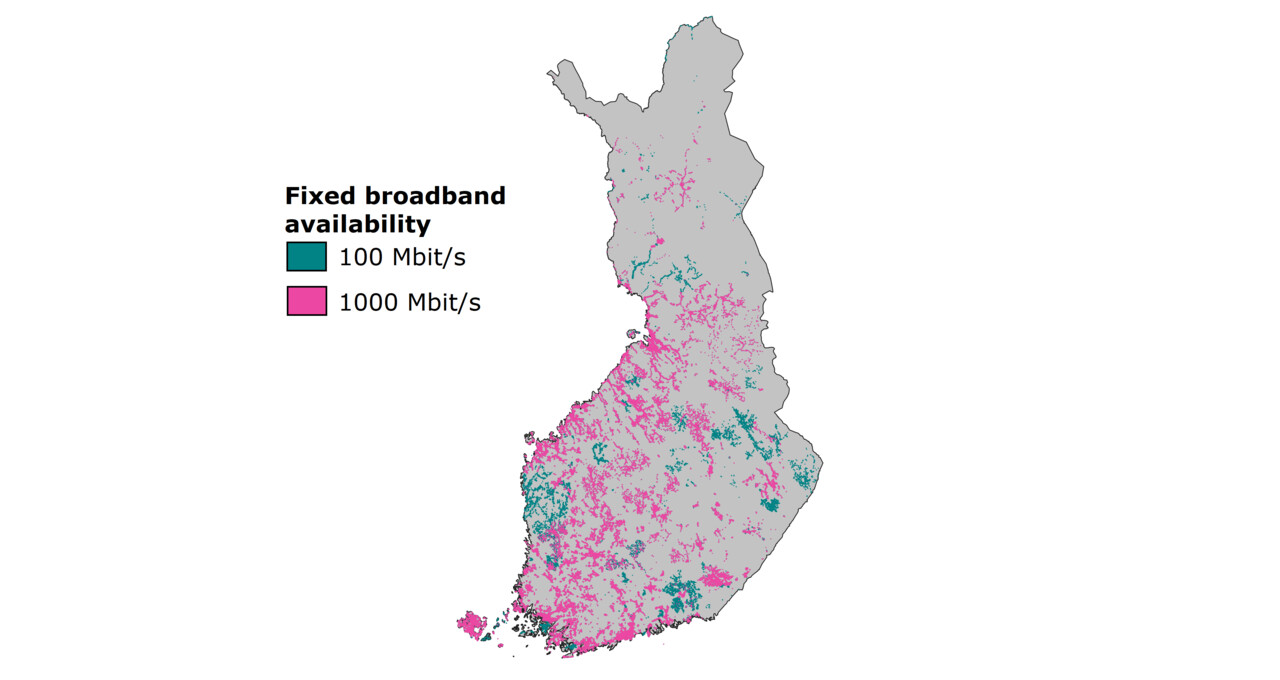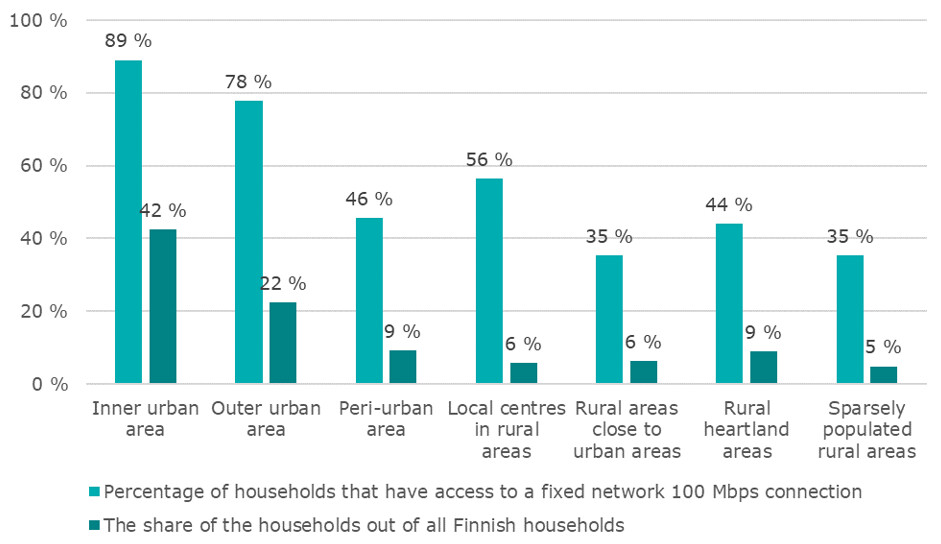According to data collected by the Finnish Transport and Communications Agency Traficom, at the end of 2021 60% of Finnish households had access to a fixed internet connection with a download speed of one gigabit, while 70% had access to a fixed internet connection with a download speed of 100 megabits. There are differences in availability between cities and rural areas, with high-speed connections concentrated around population centres and their surroundings. The optical fibre network, in particular, expands every year, and the building of broadband networks is facilitated with various forms of public funding, among other measures.
At the end of 2021, 71% of Finnish households had access to a fixed internet connection offering download speeds of at least 100 Mbps, while 60% had access to a 1 Gbps connection. Almost half of Finnish households (49%) had access to an optical fibre network connection. According to Traficom’s definition, having access means that the broadband connection could be deployed immediately, if desired, or with minimal additional construction at the edge of a residential plot, for example. The information is based on availability data collected from telecommunications operators by Traficom.
Finland still has a ways to go to reach the EU’s connectivity targets
One of the European Union’s Digital Decade 2030 targets is that all households should have access to gigabit connectivity or a connection that can be upgraded to gigabit connectivity with minimal effort. “In practice, this means either an optical fibre or cable modem connection that may currently offer only 100 Mbps connectivity to users,” states Communications Market Specialist Joonas Sotaniemi. According to Traficom’s data, there are still approximately 800,000 households in Finland that do not have access to a high-speed fixed connection.
Traficom has also collected data on the maximum upload speeds available to users. Upload speed is relevant when users upload photographs or data to cloud services or use video calls, for example. Nearly all connections offering download speeds of 100 Mbps also offer upload speeds of at least 100 Mbps.

Fixed connections concentrated around population centres – availability lower in rural areas
The collected data shows that there are differences in the availability of fixed connections between different types of areas. Traficom’s examination of 100 Mbps availability at the end of last year was carried out in accordance with the Finnish Environment Institute’s urban-rural classification. In the urban-rural classification system, areas are divided into seven regional classes based on factors such as population and construction. The clear majority of Finland’s population is concentrated in urban areas. In these areas, household access to 100 Mbps fixed connections was good, with overall coverage in areas belonging to the three urban classes being 80%. In areas belonging to the four rural classes, availability was notably lower, only 43% of households. This is indicative of the fact that high-speed broadband connections are easier and more cost-efficient to build in densely constructed, small areas.

Differences in availability can also be compared by region and municipality. The regions with the highest fixed network household availability were Åland (97%), Ostrobothnia (84%) and North Ostrobothnia (81%). In Åland, nearly all households have had access to an optical fibre network connection for several years now. In North Ostrobothnia and Ostrobothnia, fixed network 100 Mbps connectivity is based on both optical fibre and cable modem connections. The coverage of optical fibre alone was 63% in North Ostrobothnia and 59% in Ostrobothnia. Availability can be examined more closely by municipality and region on the website (External link).
Traficom supports the building of fixed broadband networks
In Finland, high-speed fixed broadband connections are built both on market terms and with the help of various forms of public funding, such as broadband aid, which is granted by Traficom, and aid for village networks, which is granted by ELY Centres. The majority of new fixed broadband networks built in Finland are based on optical fibre technology, as it is the newest fixed network technology capable of meeting Finland’s and the European Union’s gigabit connectivity targets. The building of new optical fibre networks is more common outside of the largest population centres. Another technology capable of providing gigabit connectivity is cable modem technology, which is based on the cable TV network, which is why many housing companies in larger cities offer cable modem connections instead of optical fibre connections.
Traficom collects data on the building of digital infrastructure and the development of digital services from telecommunications operators to map the current state of communications networks and forecast future needs. The collected data are used to identify areas that can be granted state aid for building broadband networks, for example.
Additional information
Region- and municipality-specific data can be examined on a map in the Data.Traficom maps service (External link).
Region- and municipality-specific information is also available in table form here (External link).
The information is available as open data here (External link).
The Finnish Environment Institute’s urban-rural classification (External link).
Other broadband statistics (External link).
Joonas Sotaniemi, Communications Market Specialist, tel. +358 295 390 309, joonas.sotaniemi@traficom.fi
Marja Heinonen, Communications Market Specialist, tel. +358 295 390 306, Marja.heinonen@traficom.fi